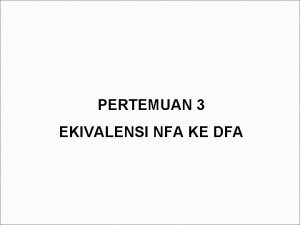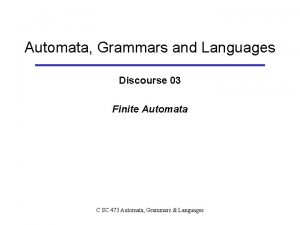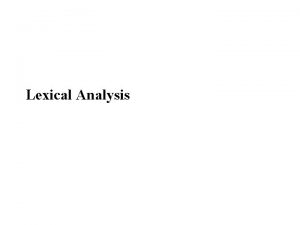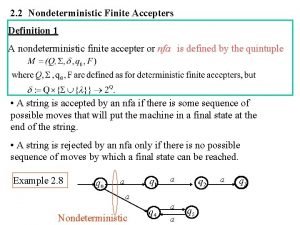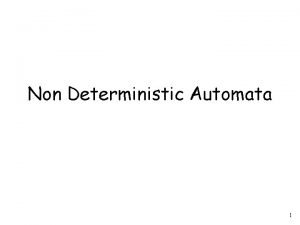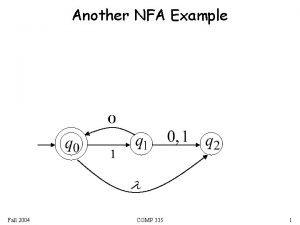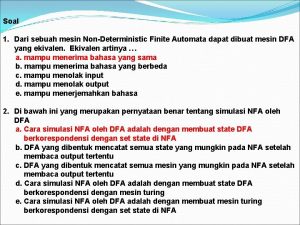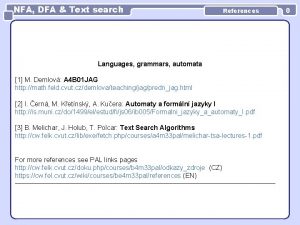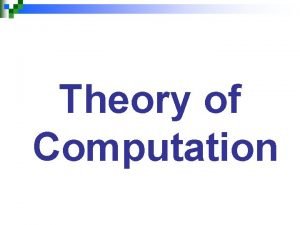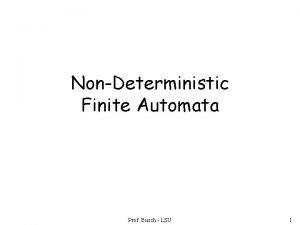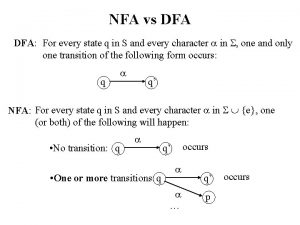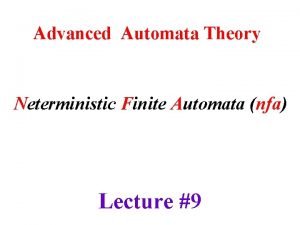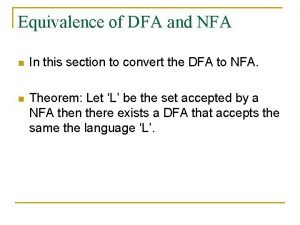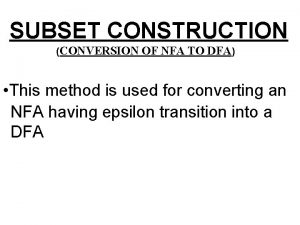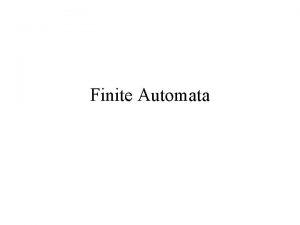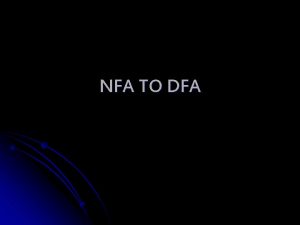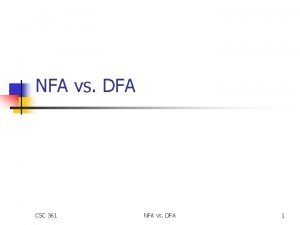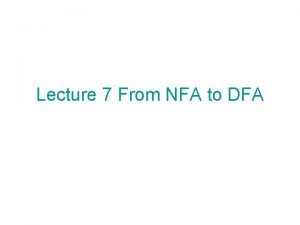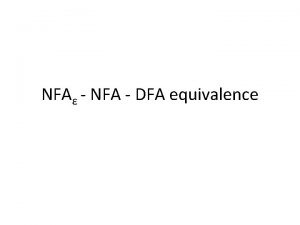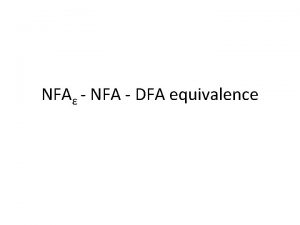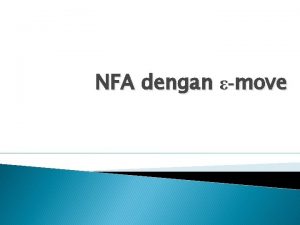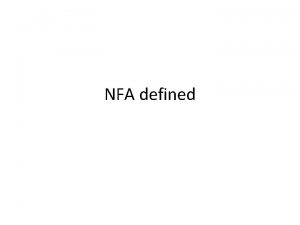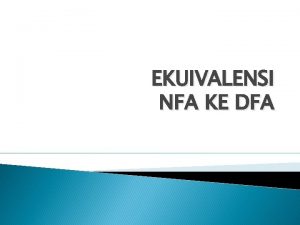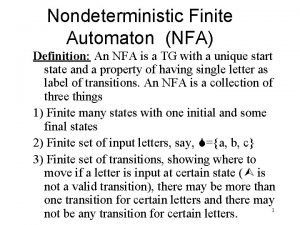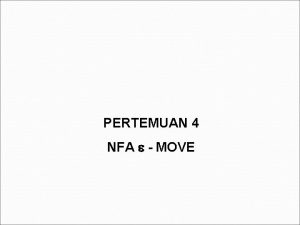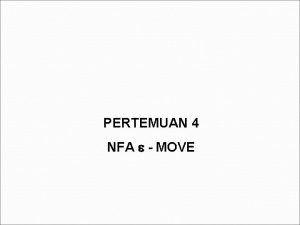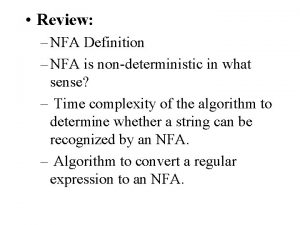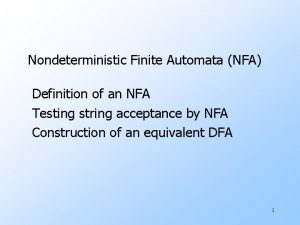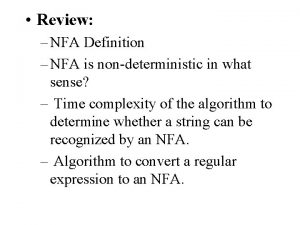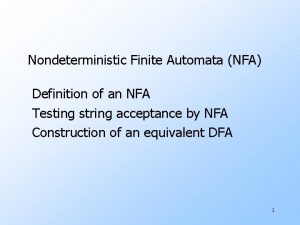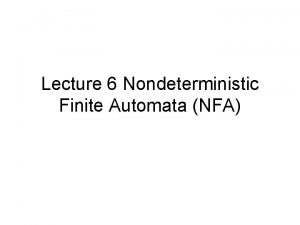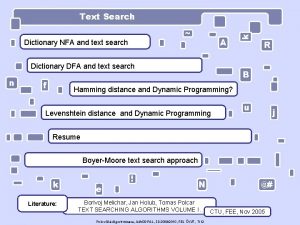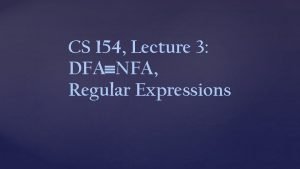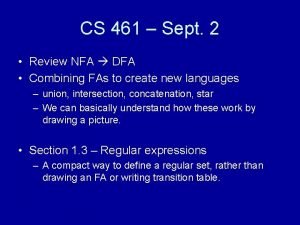NFA vs DFA CSC 361 NFA vs DFA





















- Slides: 21

NFA vs. DFA CSC 361 NFA vs. DFA 1

NFAs vs. DFAs n NFAs can be constructed from DFAs using transitions: n Called NFA- n Suppose M 1 accepts L 1, M 2 accepts L 2 n CSC 361 Then an NFA can be constructed that accepts: n L 1 U L 2 (union) n L 1 L 2 (concatenation) n L 1 * (Kleene star) NFA vs. DFA 2

Closure Properties of NFA- s M 1 M 2 L(M)* L(M 1) U L(M 2) M M 1 M 2 L(M 1) L(M 2) CSC 361 NFA vs. DFA 3

NFA to DFA Conversion CSC 361 NFA vs. DFA 4

DFA vs NFA n Deterministic vs nondeterministic n n For every nondeterministic automata, there is an equivalent deterministic automata Finite acceptors are equivalent iff they both accept the same language L(M 1) = L(M 2) CSC 361 NFA vs. DFA 5

DFA vs NFA n Deterministic vs nondeterministic n In DFA, label resultant state as a set of states n n For a set of |Q| states, there are exactly 2 Q subsets n CSC 361 {q 1, q 2, q 3, …} Finite number of states NFA vs. DFA 6

Removing Nondeterminism n n By simulating all moves of an NFA-λ in parallel using a DFA. λ-closure of a state is the set of states reachable using only the λ-transitions. CSC 361 NFA vs. DFA 7

NFA-λ p 2 λ a p 1 λ q 1 p 3 λ λ q 2 p 5 a p 4 CSC 361 NFA vs. DFA 8

λ – Closure n Selected λ closures q 1: { q 1, q 2} p 1: {p 1, p 2, p 3} q 2: { q 2} CSC 361 NFA vs. DFA 9

Equivalence Construction n n Given an NFA-λ M 1, construct a DFA M 2 such that L(M) = L(DM). Observe that n n CSC 361 A node of the DFA = Set of nodes of NFA-λ Transition of the DFA = Transition among set of nodes of NFA- λ NFA vs. DFA 10

Special States to Identify Start state of DFA = Final/Accepting state of DFA = All subsets of states of NFA-λ that contain an accepting state of the NFA-λ Dead state of DFA = CSC 361 NFA vs. DFA 11

Example a a b q 1 q 0 λ a q 2 c CSC 361 NFA vs. DFA 12

Example n Identify λ-closures n n n CSC 361 q 0: { q 0} q 1: { q 1} q 2: {q 1, q 2} NFA vs. DFA 13

Example n Identify transitions n n Start with λ-closure of start state {q 0}: Where can you go on each input? n a: {q 0, q 1, q 2} n n So, {q 0, q 1, q 2} is a state in the DFA n b, c: Nowhere, so {Φ} is in the DFA n Next slide… Next, do the same for {q 0, q 1, q 2} and {Φ} n Find destinations from any node in the set for each of the three alphabet symbols n CSC 361 Subsequent slide… NFA vs. DFA 14

All steps from {q 0} a {q 0} b c CSC 361 {q 0, q 1, q 2} Φ NFA vs. DFA 15

All steps from {q 0, q 1, q 2} a a {q 0} {q 0, q 1, q 2} {q 1} c b {q 1, q 2} Φ a, b, c CSC 361 NFA vs. DFA 16

All steps from {q 1} and {q 1, q 2} b {q 1} a, c Φ c b {q 1, q 2} CSC 361 a {q 1} Φ NFA vs. DFA 17

Equivalent DFA a {q 0} a {q 0, q 1, q 2} b b, c Φ a, c b {q 1} c c b {q 1, q 2} a a, b, c CSC 361 NFA vs. DFA 18

NFA vs. DFA Theorem: Given any NFA N, then there exists a DFA D such that N is equivalent to D • Proven by constructing a general NFA and showing that the closure exists among the possible DFA states P(Q) • Every possible transition goes to an element of P(Q) CSC 361 NFA vs. DFA 19

Limitations of Finite Automata n n Obvious: Can only accept languages that can be represented in finite memory! Can this language be represented with a FA? n n L(M)=(aibi | i n) How about this one? n CSC 361 L(M)=(aibi | i > 0) NFA vs. DFA 20

Exercise: Convert this NFA p 2 λ a p 1 λ q 1 p 3 λ λ q 2 p 5 a p 4 CSC 361 NFA vs. DFA 21
 Csc 361
Csc 361 Automata
Automata Buatlah dfa yang ekuivalen dengan nfa berikut
Buatlah dfa yang ekuivalen dengan nfa berikut Nfa to dfa conversion solved examples
Nfa to dfa conversion solved examples Dfa minimization
Dfa minimization Ekivalensi nfa ke dfa
Ekivalensi nfa ke dfa Nfa to dfa
Nfa to dfa Contoh soal nfa
Contoh soal nfa Nondeterministic
Nondeterministic Convert nfa to dfa
Convert nfa to dfa Dari sebuah mesin nfa dapat dibuat mesin dfa yang
Dari sebuah mesin nfa dapat dibuat mesin dfa yang Language
Language Nfa theory of computation
Nfa theory of computation Convert nfa to dfa
Convert nfa to dfa Dfa vs nfa
Dfa vs nfa Recursive definition of nfa
Recursive definition of nfa Equivalence of nfa and dfa
Equivalence of nfa and dfa Conversion of epsilon nfa to dfa
Conversion of epsilon nfa to dfa Automata
Automata Nfa to dfa subset construction method
Nfa to dfa subset construction method Nfa vs dfa
Nfa vs dfa Dfa
Dfa


